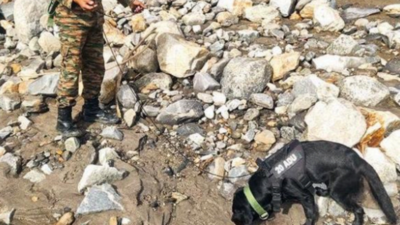ARTICLE AD BOX

Amidst a devastating scene in Dharali, a team of six Army dogs is tirelessly searching for survivors buried under debris since August 5th. Trained to detect faint human scents even deep beneath the earth, these agile canines are navigating treacherous terrain where machines cannot.
DEHRADUN: In the pale light of a rainy morning, soldiers moved across a slope of decimated earth, slowing as Hazel lowered her head, snout twitching and nostrils flaring as she swept the ground in deliberate arcs.
The labrador, in a black Army harness with SAR (search and rescue) inscribed on it, is one in the pack of six Army dogs now searching for survivors in a virtually non-existent Dharali that's buried under mounds of debris since Aug 5.
Dogs trained to detect faintest trace of human scent as deep as 15-18 ft
The pack, with silky black and golden fur coats, arrived in staggered movements from bases in Dehradun, Meerut and Lucknow. Along with Hazel are three females, Jansi, 2, Sara, 3, and June, 5, and two males, Opana, 2½, and the most field-experienced Rahi, 7, with five years of service behind her. Sara, Opana and Rahi worked in the 2024 floods in Wayanad and Shimla. The rest are here for their first deployment beyond controlled drills.June, stationed in Harsil since late May, was caught with her handler on Aug 5 between falling rock and a sudden rise in water while moving towards Dharali. They escaped but were trapped by the blocked route. Later that day, Rahi's path from Dehradun was cut by fresh slides. On Aug 6, Opana, Jansi and Sara left Meerut, and Hazel travelled from Lucknow to Dehradun.
The next day, with weather clearing briefly, all four were flown into the valley.Work for the pack begins at 6.30am and ends after 12 hours, divided into rotations to keep them sharp: an hour of searching followed by 20 minutes of rest, repeated six or seven times. In heavy terrain, the cycle shortens to 30-35 minutes with 10-minute breaks, sustained for up to three hours before a longer rest and feeding. Handlers move them in wide arcs, reading the stillness, the fixed stare or the pawing at the ground that signals a possible find.Lt Col Manish Srivastava, PRO, defence (Dehradun), told TOI that the dogs had been trained to save buried lives. "Agile, alert and precise, they are operating in areas where machines cannot go," he said.They are trained to detect the faintest trace of human scent - whether from clothing or from air trapped in collapsed structures - through four or five feet of packed mud, and in some conditions as deep as 15-18 feet. "They are our force multipliers in this operation," said an officer involved in the mission. "A lot of hope rests on them - and here, hope is measured in the narrowing of a search area, the certainty of where to dig, and the possibility that somewhere beneath the shifting earth, there is still someone alive.
"



.png)
.png)
.png)
















 2 hours ago
2
2 hours ago
2









 English (US) ·
English (US) ·